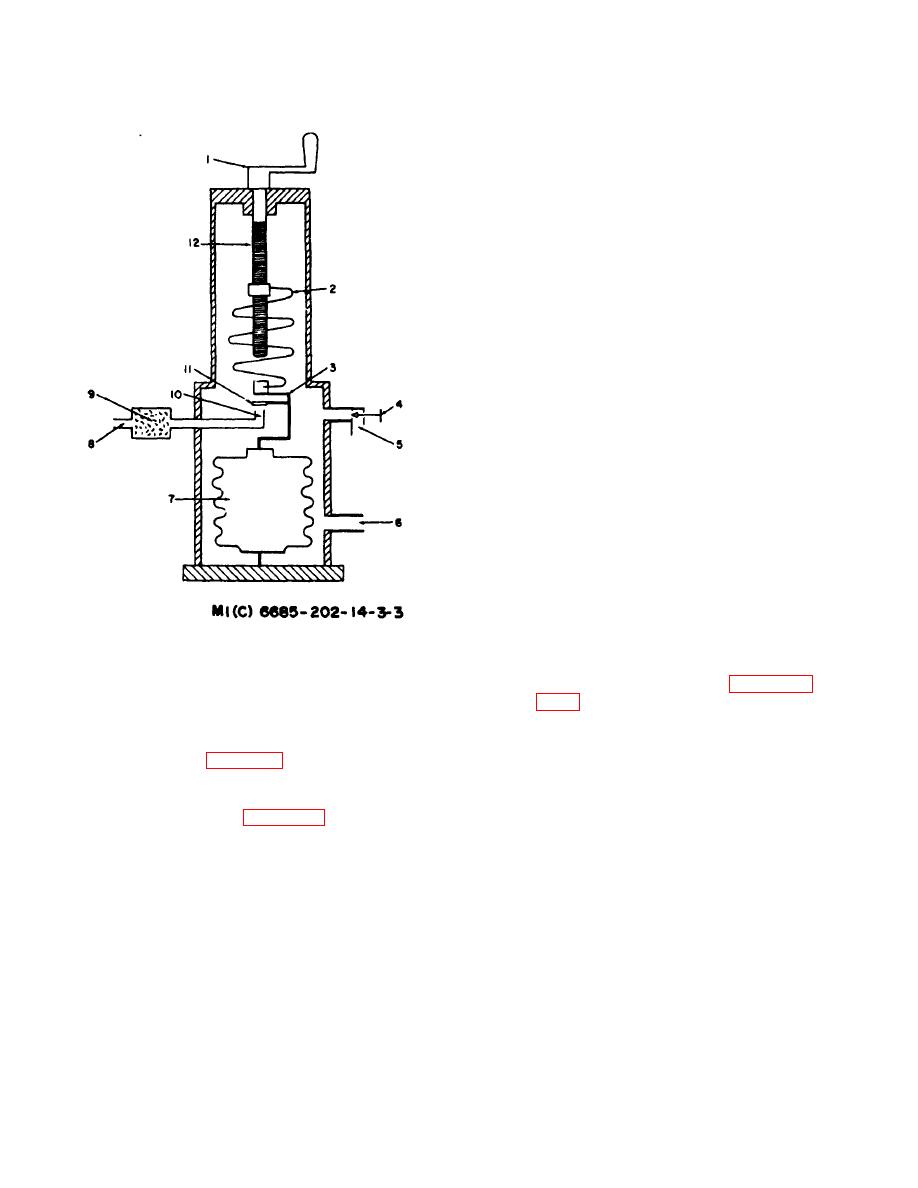 |
|||
|
|
|||
|
Page Title:
Operating Instructions |
|
||
| ||||||||||
|
|
 TM 9-6685-202-14
c. If the vacuum test chamber is to be maintained
at 15 inches of mercury absolute pressure, the
handwheel is adjusted until the desired pressure is
indicated on a manometer or indicator connected into
the system. Turning handwheel (1) clockwise increases
the absolute pressure and counterclockwise decreases
the absolute pressure. When operating at 15 inches of
mercury absolute pressure, the net resultant force of the
bellows and spring equals that applied by a pressure of
15 inches of mercury absolute, and just sufficient air
passes through port (10) to maintain equilibrium. If the
pumping rate of the source of vacuum or the
atmospheric pressure changes, the bellows immediately
reacts and throttles the air inlet so that equilibrium is
maintained.
d. In order to use the regulator on a pressure
system, connect the pressure source to air inlet (8) and
the pressure test chamber to test connection(6).
Vacuum throttling valve (4) is cracked and allowed to
vent to atmospheric pressure.
CAUTION
Take care when approaching the
limits of the operating range so that
the regulator is not forced past the
internal stops. As soon as the crank
wheel assembly binds, stop turning
the handle. If it binds at any point
other than the limit of the operating
Figure 3-3.
range, (3 to 60 inches of mercury
Constant vacuum regulator - operated wider
absolute pressure) disassemble the
vacuum.
regulator as described in paragraph
NOTE
mechanism.
The numbers in parenthesis shown
3-9. Operating Instructions
below refer to figure 3-3.
a. General. Correct sighting of the mercury level
b. The operation of the constant vacuum regulator
and reading of the barometer scale must be thoroughly
is schematically shown in figure 3-3. The source of
understood prior to using the barometer.
These
vacuum is connected to the vacuum pump connection
operations are explained in this section and are used in
(5). The vacuum test chamber, barometer, or apparatus
all applications of the barometer. These applications
where control of vacuum is desired is connected to the
include operating the instrument as a barometer, to
test connection (6). Vacuum throttling valve (4) is
calibrate altimeters, as a gage-pressure manometer, as
opened and adjusted to suit the capacity of the vacuum
a differential-pressure manometer, and as an absolute-
pump. Air inlet (8) with air filter (9) is left open to
pressure manometer. The procedures for checking the
atmospheric pressure. When adjusting handwheel (1)
level of mercury in the barometer and for removing an
is turned clockwise, adjusting screw (12) stretches
air bubble from the tube are also included.
control spring (2). The spring tension is transmitted to
bellows (7) by spring and bellows connector (3). Valve
b. Sighting the Mercury Level. Proper sighting of
disc (11) is positioned over valve port (10) by spring and
the mercury level is essential for accurate and
bellows connector (3), and valve disc (11) moves away
consistent readings. Proceed as follows:
from valve port (10) as the bellows (7) expands, and
toward valve port (10) when the bellows contracts,
thereby controlling the flow of air through the regulator.
3-8
|
|
Privacy Statement - Press Release - Copyright Information. - Contact Us |